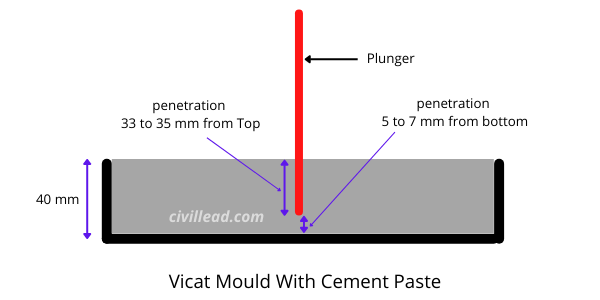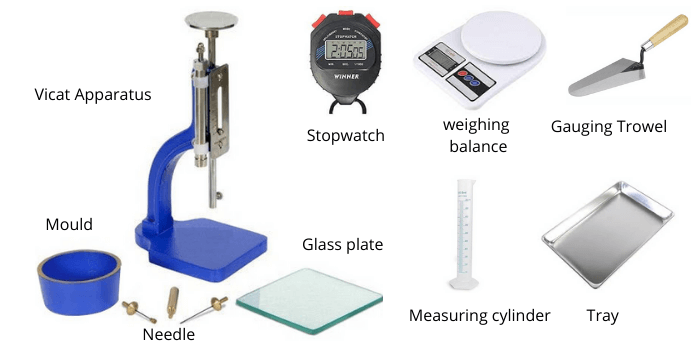Table of Contents
Consistency Test of Cement
The standard/normal consistency test of cement helps decide the amount of water needed to add to cement to achieve the normal/standard consistency of cement.
This test is performed with a Vicat apparatus to determine the quantity of water needed to add to cement that allows the Vicat plunger to penetrate cement paste up to a depth of 33- 35 from the top or 5 to 7 mm from the bottom of the Vicat mould.

Since this test is performed under standard conditions, room temperature 27± 2℃ and relative humidity of 65 ± 5% measured by hygrometer; therefore, it is known as the standard consistency test of cement.
Why is the consistency test of cement performed?
When water is mixed in cement, the hydration process takes place. If excess water is added to the cement, a high water-cement ratio causes the cement to lose its strength after hardening.
If less quantity of water is added to the cement than needed resulting in incomplete hydration and ultimately loss of cement’s strength.
The quantity of water for the standard consistency of OPC cement lies between 25 to 35%.
For making a mix of cement paste of Normal/Standard consistency, 25-35% water of cement weight is added to the cement.
For easy understanding, let us consider the value of standard consistency as 30%.
Take the quantity of cement about 400 grams and add 30% water of the amount of cement that is 120 grams to achieve a cement paste of standard consistency.
Why does the standard consistency of cement vary?
Well, there are various reasons for that, and some of them are as follows.
- Climate conditions
- Excessive composition of silica
- Fineness of the cement.
- Cement manufactured by several companies do not possess the similar consistency
How to determine the standard consistency of cement?
As stated above, the normal consistency of cement varies from area to area and site to site with the cement fineness and its composition.
Hence it becomes necessary to standardize the quantity of water mixed with cement to make the chemical reaction.
For determining the standard consistency of cement according to IS:4031-PART4-1988 VICAT APPARATUS test is done.
Object
To determine the quantity of water content in percentage of cement weight, make the specific amount of cement to a consistent paste.
Apparatus

Weight Balance
Stop Watch
Tray
Gauging Trowel
Non-porous glass plate
Measuring cylinder
Vicat Apparatus
Vicat Mould
The plunger of 10mm diameter
Procedure

- Take a cement sample of 500 grams on a tray.
- Since we have to determine the quantity of water, assume the 28% for the first trial, then increase it by 1 to 2% until the standard consistency is achieved. Measure the water quantity in a beaker.
- Now add water to the cement and mix it to prepare a paste within 3 to 5 minutes. Start a stopwatch when you add water to the cement. The time needed to prepare cement paste after adding water to mould filling is known as gauging time.
- Now place the Vicat mould on a non-porous glass plate and fill the mould with cement paste. Remove any excess cement paste from the mould and make it level with the mould top by trowel.
- Now place the mould filled with cement paste resting on a non-porous glass plate under the moving rod of the Vicat apparatus.
- Now lower the plunger smoothly and allow it to touch the cement paste surface, and then free it quickly.
- Note down the plunger penetration value from the bottom of the mould shown on the scale of the Vicat apparatus.
- Repeat the same method with changing percentages of water. The Vicat apparatus scale showed a reading between 5 to 7 mm.
Calculation and Observation Table
Weight of Cement = 500 grams
Primary percentage of water mixed to cement =
Water amount mixed to cement =
| Test No. | Cement Weight in (gm) | Water % in Mix | Quantity of Water in (ml) | Penetration Depth | Remarks |
|---|---|---|---|---|---|
| 1 | |||||
| 2 | |||||
| 3 | |||||
| 4 |
Standard Consistency of Cement = (Water quantity for penetration 5 to 7 mm/Weight of cement) X 100
Precautions
- The mould should be cleaned properly before filling the cement paste.
- The gauging time should not be shorter than 3 minutes, and it should not be greater than 5 minutes.
- The plunger should be vertical, and it should not be tapered.
- The setup placed on the working table should not have any vibration.
- The Vicat apparatus should be placed on a level surface.
- After every trial plunger should be cleaned.
Result
Water quantity in percentage for standard/Normal consistency of cement =
Also, Read
Soundness Tess of Cement By Le – Chatelier Apparatus
Specific Gravity of Cement – Definition, Importance Test Procedure
Grade of Cement – Difference Between 33, 43 and 53 Grade Cement
10 Best Cement Companies In India 2021
14 Types of Cement & Their Uses
Grade of Concrete And Their Uses – Concrete Mix Ratio